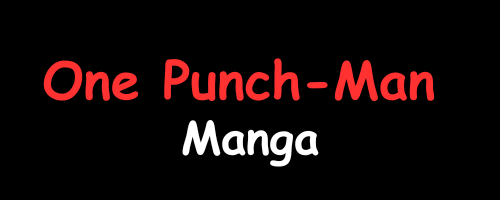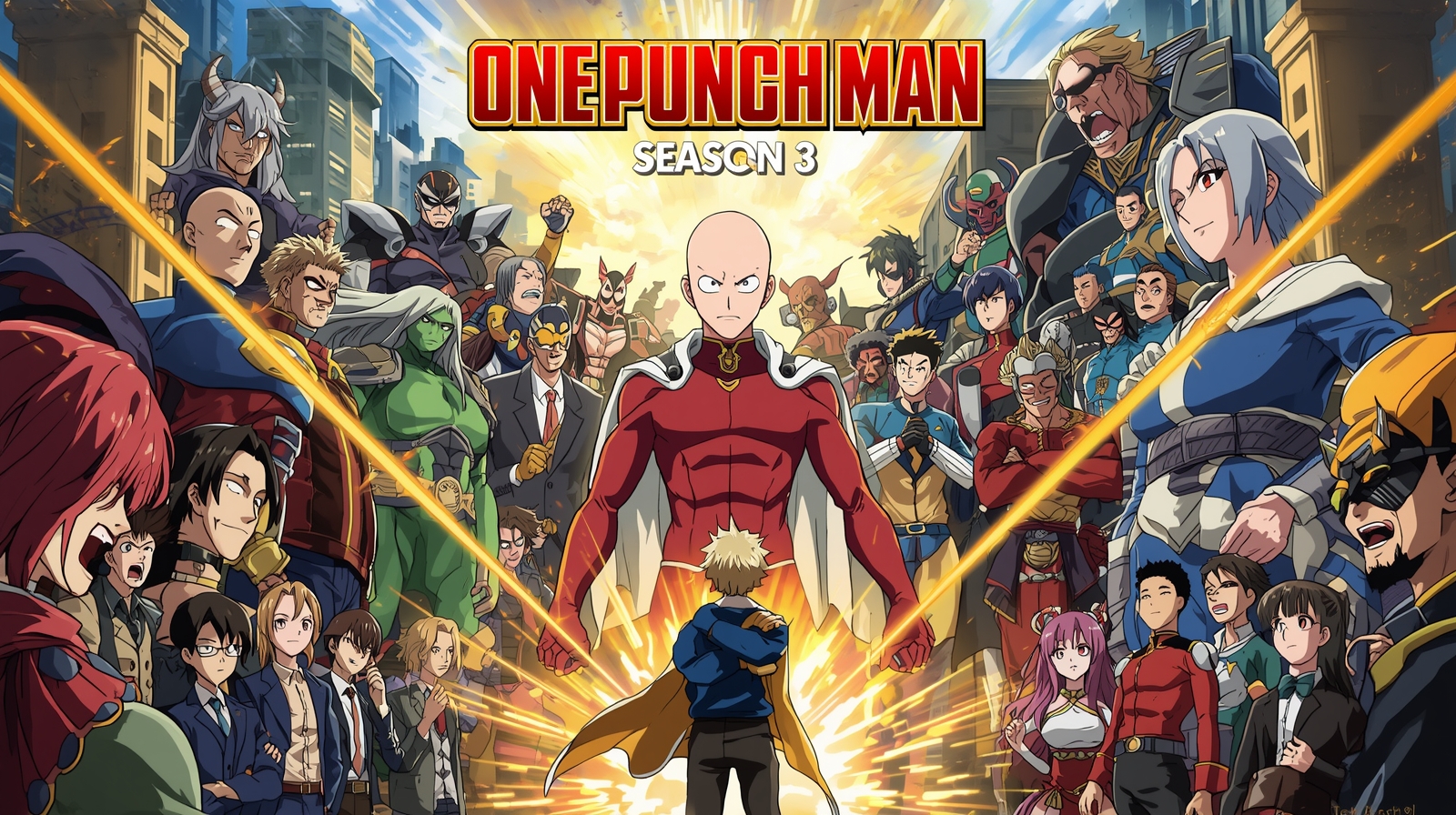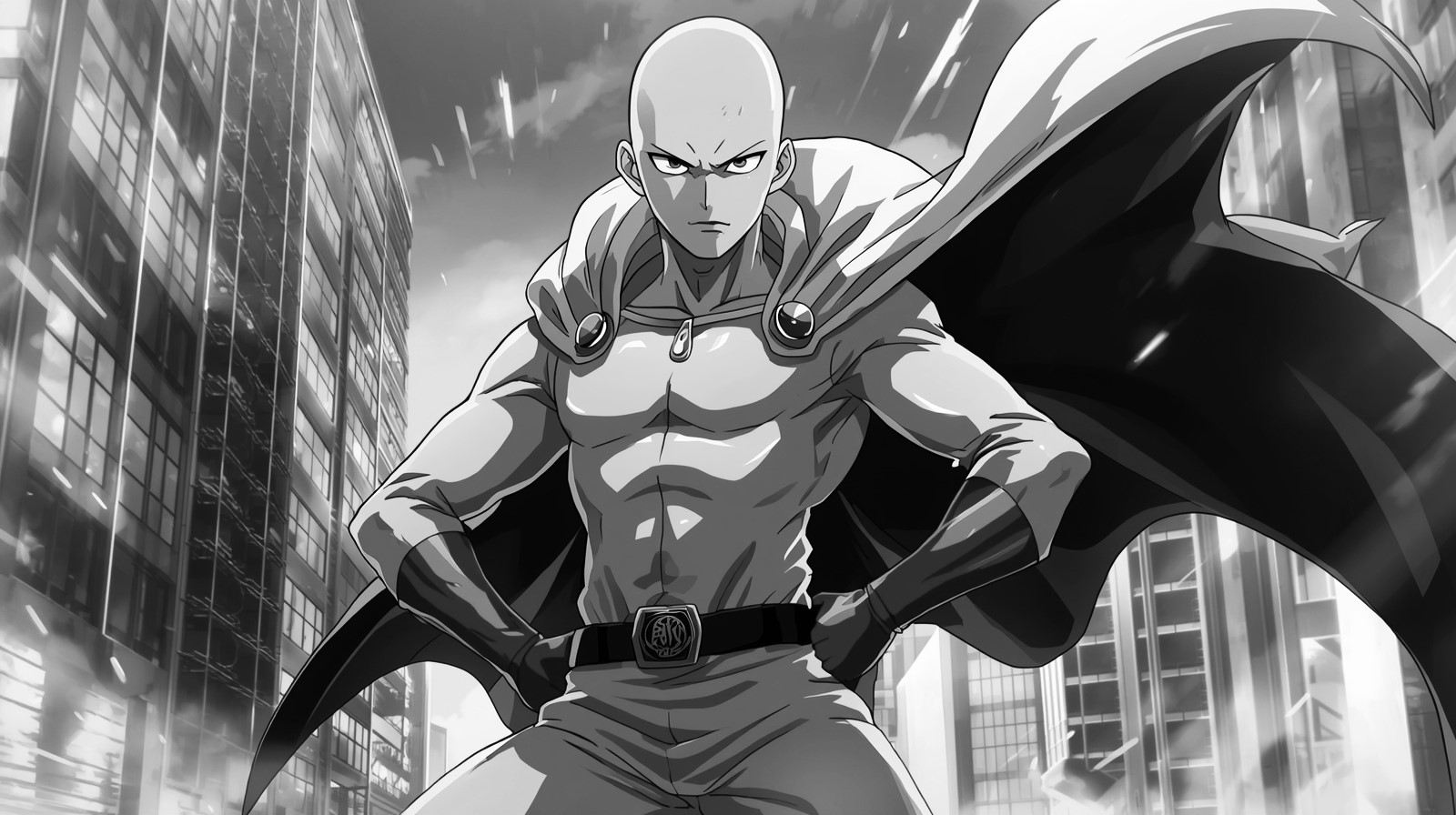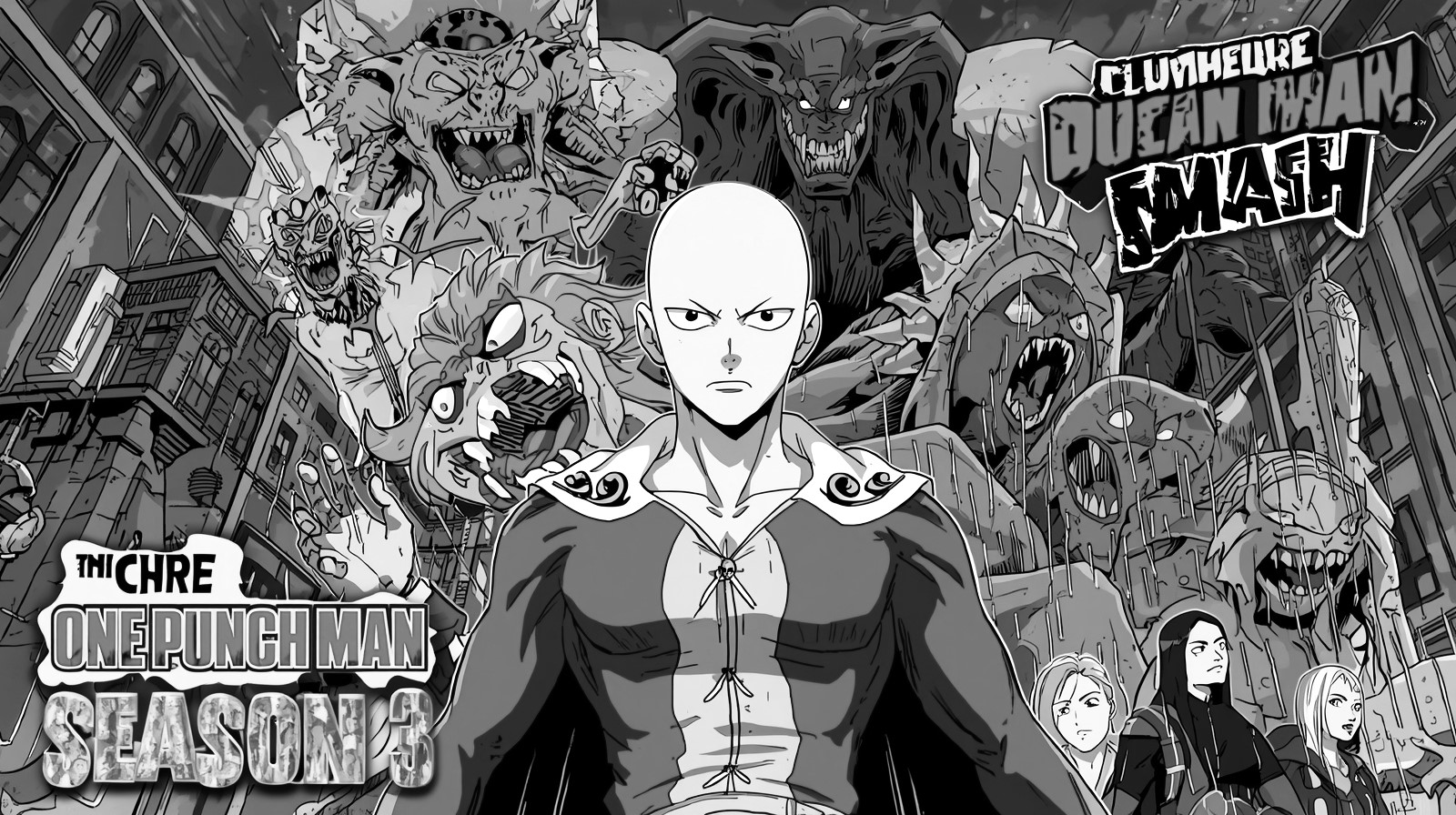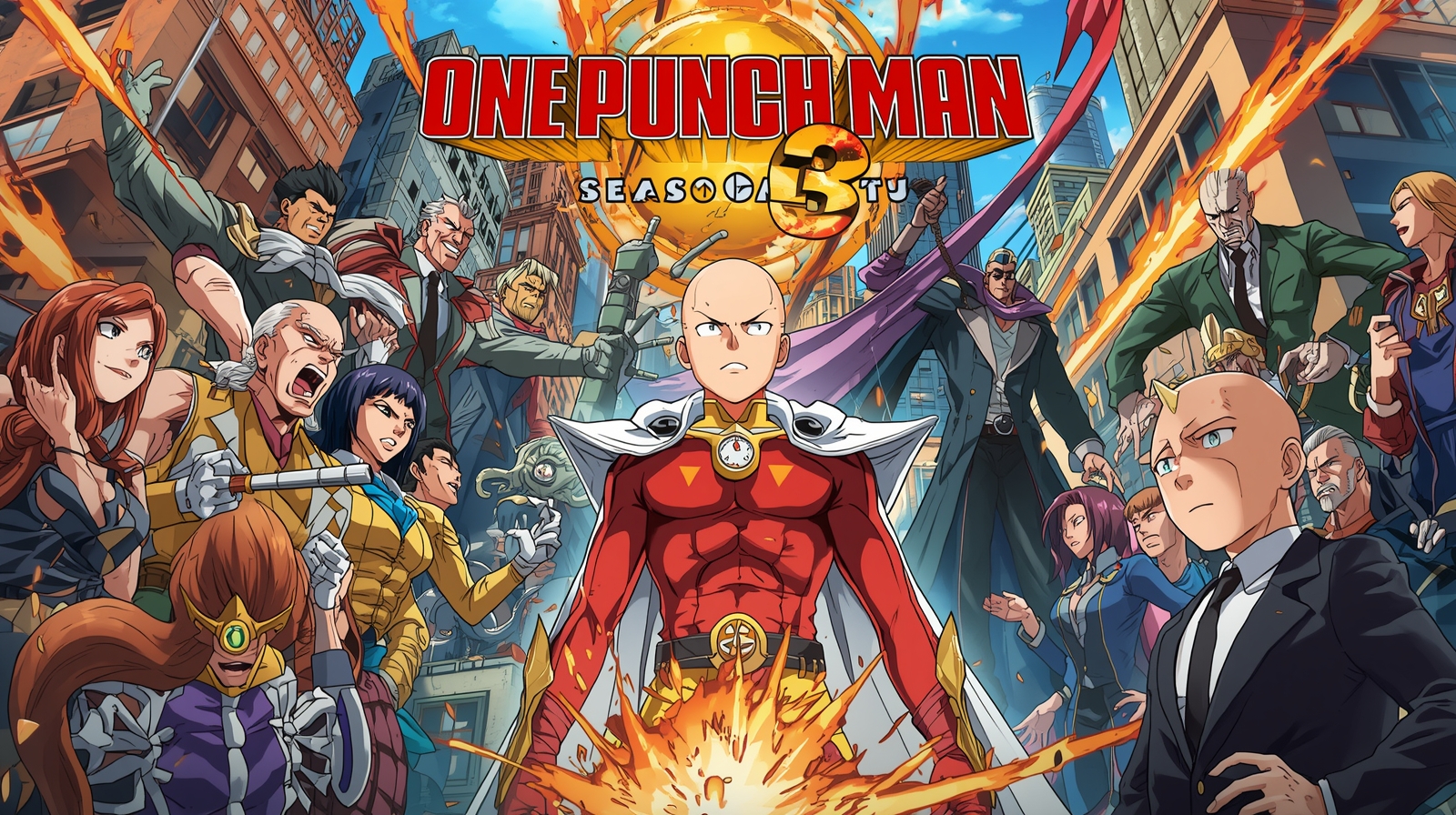One Punch Man Season 3
One Punch Man Season 3
After a long wait following Season 2’s mixed reception, One-Punch Man Season 3 is finally slated to return in October 2025. Fans of the series have been speculating, analyzing, and hoping for a comeback worthy of its first season’s glory. In this blog post, we’ll dive into everything you need to know: release date, plot theories, animation studio, cast, streaming plans, and the challenges and excitement surrounding this much-anticipated new season.
Release Date & Premiere Window—When Is One Punch Man Season 3 Coming Out?
After years of anticipation, One Punch Man Season 3 finally has an official release date, marking the return of one of anime’s most beloved heroes, Saitama. According to official announcements and industry reports, the third season is set to premiere on October 5, 2025, in Japan. This date will mark six years since the end of Season 2, which aired back in 2019. Fans have been eagerly waiting for a comeback, and this new season promises to dive straight into the intense Monster Association Arc—one of the most thrilling parts of the manga.
However, before the full season begins, rumors suggest that a recap special or Episode 0 might air on October 12, 2025, serving as a refresher for viewers and bridging the gap between Season 2 and Season 3. This would allow both returning fans and newcomers to revisit Saitama’s journey, his hilarious boredom, and the chaotic hero world that revolves around him.
The Japanese broadcast will likely begin on TV Tokyo and BS TV, followed shortly by streaming releases on major anime platforms such as Crunchyroll, Hulu, and Viz Media (depending on regional rights). Based on current licensing deals, Crunchyroll will handle streaming for regions like the UK, Europe, and Asia, while Viz Media will take care of North America and Latin America. In the United States, the season is also expected to air on Hulu, possibly with same-day or near-simultaneous streaming.
For global fans, subtitled episodes are expected to be released within 24 hours of the Japanese premiere, maintaining the simulcast trend that many major anime titles now follow. The English-dubbed version, however, may arrive a few weeks or months later, as dubbing requires extra production time.
In terms of episode count, while not yet confirmed, most sources and leaks suggest 12–13 episodes, following the standard one-cour format. This should cover a substantial portion of the Monster Association arc, including Garou’s evolution and Saitama’s rising involvement.
The Season 3 release window is particularly special because it aligns with the 10th anniversary of the One Punch Man anime project, first launched in 2015. The production team reportedly wants this season to serve as a tribute to long-time fans while reigniting global excitement around the franchise.
In summary:
-
Official Japanese Premiere: October 5, 2025
-
Possible Recap/Episode 0: October 12, 2025
-
Streaming Platforms: Crunchyroll, Hulu, Viz Media (regional)
-
Episode Count: Estimated 12–13
-
Global Simulcast: Within 24 hours for subtitled versions
-
Dubbed Release: To be announced (likely late 2025)
With the release date now set, the countdown has begun. Fans across the world are ready to see if this season will redeem the anime’s reputation and bring back the explosive animation and humor that made One Punch Man a global phenomenon.
Animation Studio & Production Team—Who’s Bringing One Punch Man Season 3 to Life
When it comes to One Punch Man Season 3, one of the most talked-about aspects is the animation studio and production team. After the critical acclaim of Season 1 and the divided opinions surrounding Season 2, fans have been eagerly awaiting confirmation of who will handle the animation this time. Let’s break down all the details about the creative team, studio, and what it means for the quality of the upcoming season.
The Return of J.C. Staff
One Punch Man Season 3 will once again be animated by J.C. Staff, the same studio responsible for Season 2. J.C. Staff has worked on several popular titles like Food Wars!, Toradora!, and DanMachi, but their handling of One Punch Man in the second season faced heavy criticism for inconsistent fight scenes, reduced frame rates, and limited dynamic motion compared to Madhouse’s Season 1.
Despite the backlash, J.C. Staff has promised to improve visual fidelity, camera work, and fight choreography in Season 3. Early previews suggest that the studio is investing more time in action scenes and overall design polish.
Director Shinpei Nagai Steps Forward
A major change in the creative leadership comes with Shinpei Nagai, the newly announced director for One Punch Man Season 3. Initially, Nagai kept his name hidden due to concerns about fan reactions—being relatively unknown in the anime industry, he feared judgment based solely on reputation.
However, after fan curiosity peaked, he officially confirmed his involvement, expressing both humility and dedication to creating a season that meets the high expectations of viewers. In a public statement, Nagai apologized for concealing his role but reassured fans that he is fully committed to bringing the Monster Association Arc to life with depth and intensity.
Comparison with Madhouse’s Season 1 Legacy
Season 1, produced by Madhouse, set a nearly unbeatable standard for fluid animation and stylish combat. Directed by Shingo Natsume, it blended high-speed motion, cinematic framing, and expressive character design that perfectly matched the manga’s tone.
Season 2’s transition to J.C. Staff, under Chikara Sakurai, marked a noticeable shift—still watchable but less visually explosive. For Season 3, the production team faces the challenge of bridging that gap while dealing with a more complex arc filled with large-scale battles, monster designs, and group confrontations.
Staff Reinforcements & Creative Adjustments
To enhance production quality, several new key animators and storyboard artists have joined the team. While the full staff list has not yet been disclosed, leaks suggest collaboration with freelance animators and guest directors to ensure standout sequences in crucial battles like Garou vs. Heroes and Saitama vs. Orochi.
There are also rumors that Madhouse veterans may assist in specific scenes or contribute as animation supervisors, hinting at potential cross-studio cooperation to meet fan standards.
Studio Commitment & Production Timeline
Production reportedly began quietly in late 2023, allowing nearly two years of development time before its October 2025 release. This is notably longer than the rushed production of Season 2, which had a tighter schedule and fewer pre-production assets.
According to inside sources, J.C. Staff is using improved 3D compositing, motion capture, and frame optimization tools to give smoother transitions between cuts. The studio also aims to achieve more cinematic storytelling during large-scale monster battles.
Director’s Vision & Thematic Focus
Director Shinpei Nagai has expressed that his goal is not merely to animate flashy fights but to capture emotional contrast—the absurd humor of Saitama’s effortless strength against the world’s chaos and ambition. He wants Season 3 to explore Garou’s internal conflict, humanizing him while portraying the Monster Association’s apocalyptic threat.
He emphasized a “balance between spectacle and satire,” echoing what made Season 1 special: mixing epic destruction with tongue-in-cheek comedy.
Fan Expectations & Studio’s Pressure
Given how divisive Season 2 was, the pressure on J.C. Staff is enormous. Fans are watching closely for signs of improvement, especially in dynamic battle scenes. If the studio succeeds in refining choreography, using better lighting, and maintaining consistency, Season 3 could be a redemption arc for J.C. Staff as much as it is for Garou in the story.
Nagai’s leadership, combined with longer production time and advanced tools, gives hope that One Punch Man Season 3 will reclaim its visual supremacy and narrative humor that made it an international phenomenon.
Final Thoughts
While skepticism remains, the current production setup shows promising direction. With J.C. Staff determined to regain trust, and Shinpei Nagai aiming for a bold, emotionally charged adaptation, Season 3 could finally bring One Punch Man back to its peak form. The animation studio’s experience, coupled with renewed fan engagement, sets the stage for one of 2025’s most anticipated anime revivals.
Key Characters & Cast Returning: The Heroes (and Villains) Are Back in Action!
The world-saving (and world-destroying) ensemble that fans know and love is officially returning for Season 3. The core Japanese voice cast, celebrated for perfectly capturing the essence of their characters, is set to reprise their iconic roles. Get ready to hear these familiar voices once more:
-
Saitama voiced by Makoto Furukawa
The Caped Baldy himself returns. While he searches for a thrilling fight, his voice will continue to masterfully blend deadpan monotone with moments of genuine, grocery-sale-fueled excitement. -
Genos voiced by Kaito Ishikawa
The Demon Cyborg and most dedicated disciple in the Hero Association is back for more action and life lessons. Ishikawa will once again deliver Genos’s intense lines with passionate conviction, whether he’s annihilating monsters or meticulously documenting Saitama’s wisdom. -
Garou voiced by Hikaru Midorikawa
The Human Monster takes center stage. Midorikawa’s powerful and menacing performance will be crucial as he brings the complex rage, philosophy, and relentless drive of the Hero Hunter to life.
Returning Heroes & Key Figures:
The Hero Association’s ranks are reassembling to face the new threat. Look forward to the return of:
-
Tatsumaki, The Tornado of Terror voiced by Aoi Yuki
The S-Class Rank 2 esper brings back her immense power and famously short fuse. Yuki’s ability to switch from a condescending, high-pitched taunt to a earth-shattering roar is a performance not to be missed. -
Bang voiced by Kazuhiro Yamaji
The venerable Silver Fang returns, bringing his unparalleled martial arts mastery and fatherly wisdom (and frustration) towards Garou. -
King voiced by Hiroki Yasumoto
The “Strongest Man on Earth” and Saitama’s best gaming buddy is back. Yasumoto’s deep, imposing voice perfectly contrasts with King’s internal panic, making for some of the series’ best comedic moments. -
Fubuki, The Blizzard of Hell voiced by Saori Hayami
The B-Class Rank 1 leader of the Blizzard Group returns, continuing her complex relationship with her sister Tatsumaki and her fascination with Saitama’s hidden power. -
Dr. Kuseno voiced by Tesshō Genda
The genius scientist and father figure to Genos will be back to provide upgrades, wisdom, and maintain the cyborg’s impeccable internal hardware.
New and Escalating Antagonists:
The Monster Association arc is in full swing, meaning a host of terrifying Executives and their minions will be menacing humanity. While specific new castings are often announced later, expect the formidable voices of the Monster Association leadership to play a major role, building upon the foundation set in Season 2.
One Punch Man Season 3: New & Revealed Monster Designs
As the Hero Association crumbles and the monstrous threat of the Monster Association escalates, One Punch Man Season 3 is poised to deliver the most visually stunning and narratively significant creature designs in the series’ history. Moving beyond the city-level threats, this season delves into a full-scale war, introducing a horrifying bestiary that pushes the limits of animation and horror. Here’s a complete breakdown of what to expect.
The Monster Association Cadre: A Gallery of Nightmares
The core of this season’s threat comes from the elite inner circle of the Monster Association, known as the “Cadre.” Each design is a masterpiece of grotesque creativity, reflecting their powers and twisted psyches.
-
Psykos (The Evil Eye & Fusion Form):
-
Initial Design: Psykos is revealed not as a monstrous beast, but as a calculating, humanoid figure with a dominant, unblinking third eye. This design emphasizes her role as the mastermind—cold, intelligent, and always watching. Her costume is regal yet sinister, befitting an oracle of doom.
-
Fusion Form (Psykos-Orochi): The season’s most jaw-dropping reveal. This is not a simple combination but a terrifying symbiotic entity. Psykos’s upper body emerges from a colossal, serpentine mass of flesh, energy, and countless dragon heads—the remains of Orochi. The design is a chaotic whirl of eyes, mouths, and psychic energy tendrils, representing the ultimate fusion of immense psychic power and raw, monstrous biology.
-
-
Evil Natural Water:
-
Design Philosophy: Pure, unsettling simplicity. Appearing as a hovering, sentient mass of clear water, its design is deceptively calm. The horror comes from its featureless form and the deadly, high-pressure water cannons it manifests. Its ability to shape-shift and its absolute neutrality make it one of the most uniquely terrifying designs.
-
-
Gums:
-
Design Philosophy: Primal, visceral horror. Gums is a walking, bloated stomach with legs. His entire body is a massive maw, lined with rows of jagged teeth and a single, beady eye. The design is a rejection of complexity in favor of a raw, consuming hunger. Every movement is slobbering, squelching, and utterly repulsive.
-
-
Fuhrer Ugly:
-
Design Philosophy: Body horror and grotesque vanity. Ugly begins as a portly, arrogant figure but his true monstrous form is a lumpy, melting mass of flesh with a distorted face. The design is meant to be repulsive, reflecting his own deep-seated insecurities and hatred for beauty. His “ugliness” is literally weaponized.
-
-
Black Sperm:
-
Initial Design: Deceptively comical. He appears as a small, cartoonish, sperm-like creature with a cheerful demeanor. This design brilliantly masks his true, apocalyptic nature.
-
Revealed Potential: The true horror of his design is revealed through his abilities. He can merge countless copies of himself into increasingly powerful and monstrous forms, culminating in the legendary Golden Sperm, a being of perfect, sleek, and overwhelming power whose design is a stark contrast to the chaotic bulk of other monsters.
-
The Mysterious “Homeless Emperor”
-
Design Philosophy: Subversion of expectation. In a world of mutated beasts, Homeless Emperor appears almost entirely human. His design is simple: a disheveled man in ragged clothes. The monstrous element comes not from his body, but from the divine, luminous energy he wields. This contrast highlights that the source of his power is external and far more sinister, tying into the deeper lore of the series’ god-like entity.
The Enigmatic “God”
-
The Reveal: Season 3 will provide the most significant look yet at the enigmatic being granting power to characters like Homeless Emperor and Psykos. The design is minimalist yet profoundly unsettling. It’s often depicted as a silhouette against a blood-red moon, or a humanoid figure with a featureless, cracked stone face, sometimes adorned with glowing lines. This design choice creates an aura of incomprehensible, cosmic malevolence, setting up the ultimate antagonist of the entire series.
Enhanced & Multi-Headed Monsters
The rank-and-file monsters of the Association also receive significant upgrades.
-
Overgrown Rover: The “goodest boy” of the Monster Association is a colossal, multi-story hellhound with multiple eyes and mouths. Its design blends the familiar shape of a dog with the scale and power of a dungeon boss, making it both intimidating and strangely endearing.
-
Senior Centipede: A direct evolution of the Centipede species Saitama has faced before. This one is exponentially larger, with a more armored, segmented body and a face full of even more terrifying pincers, showcasing the recurring theme of “bigger, badder” versions of existing threats.
Overall Design Themes & Artistic Direction:
-
Narrative Through Design: Unlike previous seasons, the monster designs are not just random threats. Each Cadre member’s form directly reflects their personality, backstory, and deepest insecurities (vanity, hunger, rage, etc.).
-
Scale & Scope: The designs emphasize the sheer scale of the conflict. We move from single monsters attacking a city to a horde of uniquely designed creatures swarming an entire landscape.
Contrast with Heroes: The organic, chaotic, and often grotesque designs of the monsters create a powerful visual contrast with the sleek, technological, or uniformed designs of the S-Class heroes, highlighting the ideological war at the heart of the arc.
One Punch Man Season 3: Challenges & Risks Ahead
The long-awaited third season of One Punch Man is poised to adapt the most ambitious, action-packed, and philosophically complex arc of the manga yet: The Monster Association Arc. While this promises an incredible spectacle, the journey to the screen is fraught with significant challenges and risks that will define the season’s success.
Narrative & Storytelling Challenges
The core of Season 3’s risk lies in the source material itself. The Monster Association Arc is a narrative behemoth.
-
The Saitama Paradox: The central joke of the series—an invincible protagonist—faces its greatest test. How do you maintain tension and stakes when the main character cannot be harmed?
-
The Solution & Risk: The narrative wisely shifts focus to the extended cast of S-Class and A-Class heroes. Their brutal, high-stakes battles against the Cadres form the emotional core. The risk is that if these fights are not animated with breathtaking quality and emotional weight, the entire season could feel like filler until Saitama arrives.
-
The Ultimate Challenge: Making the audience forget about Saitama during these fights, only to have his arrival be the ultimate catharsis.
-
-
Pacing and Tone Whiplash: The arc rapidly oscillates between:
-
Extreme, visceral violence and horror (deaths, dismemberments, psychological torture).
-
Character-driven drama (Garou’s internal conflict, Child Emperor’s breakdown, Tatsumaki’s past).
-
Absurdist comedy (King’s “ultimate luck,” Saitama’s casual interludes).
-
The Risk: Poor pacing could undermine serious moments or make the comedy feel jarring and out of place. Balancing these tones is a delicate tightrope walk.
-
-
Garou: The Complex Antagonist: Garou is not a traditional villain. He is a misguided anti-hero, a “hero-hunter” who believes he is creating world peace through fear.
-
The Challenge: The anime must effectively convey his internal monologue and twisted ideology. If handled poorly, he could be perceived as a generic, angry villain, losing the nuance that makes him one of the most beloved characters in the series.
-
The Human Monster: His transformation is as much psychological as it is physical, and capturing that descent is crucial.
-
Production & Animation Risks
This is the single biggest concern for the fanbase, given the studio change from Madhouse (Season 1) to J.C. Staff (Season 2).
-
The Shadow of Season 1: The legendary animation of Season 1, particularly the Boros fight, set an impossibly high bar. Season 2, while competent, was widely seen as a significant step down in fluidity and impact.
-
The Risk: If Season 3’s animation fails to meet the heightened demands of this arc—which features more characters, more complex powers, and larger-scale destruction than the Boros fight—it will be considered a catastrophic failure by the core audience.
-
-
The Scale of the Battles: This arc isn’t one or two big fights; it’s a symphony of them happening simultaneously. Key battles that demand top-tier animation include:
-
Tatsumaki vs. Psykos (a city-lifting, reality-warping duel).
-
Garou vs. the S-Class (a brutal, one-sided slaughter).
-
Flashy Flash vs. Hellfire Flame and Gale Wind (a high-speed battle invisible to the naked eye).
-
Superalloy Darkshine vs. Garou (a clash of ultimate offense vs. ultimate defense).
-
The Risk: Animating any one of these fights is a huge undertaking. Animating all of them, with consistent quality, is a monumental task that could stretch any studio’s resources thin.
-
-
Director and Staff: The vision of the director and the skill of the key animators will be paramount. A clear, dynamic directorial style is needed to handle the chaotic, multi-level battlefield. The recruitment of talented freelance action animators (sakuga) could make or break the pivotal moments.
Character & Thematic Challenges
-
Overwhelming Cast: The Monster Raid is a massive ensemble piece. Dozens of heroes and monsters are introduced or given significant screen time.
-
The Risk: Neglecting character moments in favor of non-stop action. The audience needs to care about these heroes when they are in peril. Characters like Pig God, Drive Knight, and Zombieman need their moments to shine without feeling rushed.
-
-
The Theme of “Justice”: This arc deconstructs the very concept of heroism. The Hero Association’s bureaucracy and corruption are contrasted with Garou’s “absolute evil” and Saitama’s “hobby for fun.”
-
The Challenge: The narrative must navigate these complex themes without becoming preachy or bogging down the plot. The ultimate message about what it truly means to be a hero needs to land with emotional resonance.
-
How to Catch Up Before One Punch Man Season 3: Your Ultimate Preparation Guide
With One Punch Man Season 3 on the horizon and promising an epic adaptation of the “Monster Association Arc,” it’s the perfect time to get back into the world of Saitama. Whether you’re a lapsed fan or a complete newbie, this guide will get you from zero to hero in no time.
The Essential Catch-Up: Watch Seasons 1 & 2
First things first, you need to experience the main story. The animation style may shift between seasons, but the core narrative is a must-watch.
-
Season 1 (2015): A near-perfect 12-episode masterpiece. It introduces Saitama, Genos, and the Hero Association, establishing the series’ unique blend of jaw-dropping action and hilarious satire. Where to Watch: Crunchyroll, Hulu, Netflix (varies by region).
-
Season 2 (2019): This 12-episode season, animated by J.C. Staff, expands the world significantly. It introduces key new heroes like King and delves deeper into the rising threat of the Monster Association, ending on a massive cliffhanger. Where to Watch: Crunchyroll, Hulu.
The “I Forgot the Details” Speed Run: Key Recap Points
If you’ve seen the show but it’s been a while, here’s a quick refresher on the critical plot points leading into Season 3:
-
Saitama’s Problem: He’s so powerful he defeats any enemy with a single punch, leading to immense boredom and a lack of recognition.
-
The Hero Hierarchy: The Hero Association ranks heroes from C-Class to S-Class. Saitama is stuck in B-Class due to a poor written exam, while Genos is a top-tier S-Class.
-
The End of Season 2 Cliffhanger: The Monster Association, led by the mysterious Orochi, has officially declared war on humanity. Their ultimate weapon? They’ve kidnapped a child named Waganma and, more importantly, Saitama’s neighbor and friend, Tareo, along with his pet, the Monster King candidate, Garou.
Beyond the Anime: Diving into the Manga (Highly Recommended)
The anime only covers part of the story. The manga is where the One Punch Man experience truly shines, especially for the upcoming arc.
-
Why Read the Manga?
-
Stunning Art: Yusuke Murata’s artwork is legendary, offering fight scenes and detail that are often impossible to fully replicate in animation.
-
Ahead of the Anime: The manga is far ahead of the anime’s current point. Season 3 will adapt the “Monster Association Arc,” which is one of the most celebrated arcs in shonen history.
-
More Content: You’ll get the complete, uninterrupted story without production delays.
-
-
Where to Start Reading After Season 2:
-
It’s recommended to start from Chapter 85 to seamlessly continue from the anime’s endpoint. However, many fans suggest starting from Chapter 84 as it contains a small but impactful scene with Saitama and King that the anime skipped.
-
Character Refresh: Who’s Who Before the War
The Monster Association Arc is a massive ensemble story. Remember these key players:
-
Saitama: Our protagonist. Still just looking for a good fight and a sale at the supermarket.
-
Genos: The Demon Cyborg, determined to become stronger and uncover the secret of the mad cyborg who destroyed his hometown.
-
Garou: The “Hero Hunter.” A former disciple of Bang who believes the world’s morality is skewed and aims to become the ultimate monster to create a world of “ultimate evil.”
-
The S-Class Heroes: Pay special attention to Tatsumaki (The Tornado of Terror), Silver Fang (Bang), Atomic Samurai, Child Emperor, and King (The Strongest Man on Earth, who relies entirely on his reputation and Saitama’s coincidental interventions).
-
The Monster Association: A cadre of powerful Dragon-level threats, including Gyoro Gyoro (the strategist), Orochi (the Monster King), and executives like Overgrown Rover, Gums, and Fuhrer Ugly.
What to Expect in Season 3: The Monster Association Arc
This is why everyone is so excited. Season 3 will be an all-out war.
-
The Setup: The S-Class Heroes launch a full-scale assault on the Monster Association’s underground lair to rescue the hostages and eradicate the monster threat.
-
The Spectacle: Expect non-stop, high-stakes battles as each S-Class hero faces off against a terrifying Dragon-level monster. The scale of destruction and the level of power on display will dwarf anything seen in the anime so far.
-
The Core Conflict: The arc brilliantly interweaves the chaos of the hero-monster war with the parallel stories of Garou’s transformation and Saitama’s… well, Saitama’s casual stroll through the apocalypse.
Your Personal Catch-Up Plan: Choose Your Path
-
For the Time-Crunched Fan:
-
Watch a detailed “Season 1 & 2 in 10 Minutes” recap video on YouTube.
-
Read manga Chapters 84 to ~110 to get a solid grasp of the arc’s beginning.
-
-
For the Dedicated Fan:
-
Re-watch both seasons at your leisure.
-
Watch all the OVAs for extra fun.
-
Start reading the manga from Chapter 84 and enjoy the incredible art and story at your own pace. You’ll be fully prepared and then some.
-
-
For the New Viewer:
Start with Season 1, Episode 1. Enjoy the ride! You have plenty of time to experience one of the most unique and entertaining anime of the last decade.
One Punch Man Season 3: The Monster Association Conclusion
Season 3 would adapt the epic climax of the “Monster Association Arc,” one of the most celebrated sagas in the manga. The entire season would be built around the concept of Conclusion—the end of the immediate conflict, the resolution of character journeys, and the profound consequences that reshape the world.
Part 1: The Climactic Battles (Episodes 1-8)
This section concludes the brutal fights deep within the Monster Association base, where the S-Class heroes are pushed to their absolute limits.
-
Garou’s Awakening: The season would open with the conclusion of battles like Flashy Flash vs. Hellfire Flame and Gale Wind, and Pig God’s secret mission. The core focus, however, is on the wounded Garou. His body, broken by the combined might of the S-Class, begins to undergo a monstrous transformation. This is the conclusion of his human resistance; he fully embraces the “Absolute Evil” he thinks the world needs to achieve his twisted sense of balance.
-
The S-Class’s Humiliation: The newly evolved “Hero Hunter” Garou systematically defeats the entire S-Class roster. This serves as a brutal conclusion to the era of S-Class invincibility. It’s not just a physical defeat but a psychological one, proving that raw power alone is insufficient against a true calamity.
-
The King Arrives: Just as all hope seems lost, Saitama, having taken the wrong turn (as usual), finally arrives at the surface with the rescued child, Tareo. This marks the conclusion of the side-quest and the beginning of the main event.
Part 2: The Ultimate Confrontation (Episodes 9-11)
This is the heart of the season, where the central themes of the arc reach their conclusion.
-
Saitama vs. Garou: The long-awaited battle begins. However, it’s not the explosive clash one might expect. It’s a one-sided, philosophical dismantling. Garou, in his ultimate “Monster Garou” form, cannot land a single blow. Saitama is utterly bored. This fight is the conclusion of Garou’s entire ideology.
-
The “Talk No Jutsu” Punch: Saitama doesn’t just defeat Garou with physical strength. He verbally deconstructs his motivations, pointing out that a real monster wouldn’t protect a child (Tareo). Saitama’s final punch isn’t just to win; it’s to conclude Garou’s internal conflict. It shatters his monstrous shell and forces him to confront the scared, idealistic child within who just wanted to play the villain.
-
The Conclusion of Garou’s Arc: Beaten and reverted to his human form, Garou is taken by the Hero Association. His dream of becoming the ultimate monster is concluded in absolute failure, but Saitama’s actions plant a seed for a potential redemption, leaving his ultimate fate open-ended yet his current journey complete.
Part 3: The Aftermath and a New World Order (Episodes 12-13)
The final episodes deal with the conclusion of the entire saga and its staggering consequences.
-
The Public’s Conclusion: The world witnesses the aftermath. The Hero Association, whose S-Class heroes were utterly defeated, loses public trust. In contrast, the mysterious Blast and his team make their first public appearance to contain the radiation left by Garou, introducing a new, cosmic-level power.
-
The Rise of the Neo Heroes: This is the most critical setup for the future. The public’s shaken faith concludes with the official formation of a rival organization: The Neo Heroes. They promise advanced technology, better management, and heroes who won’t fail like the S-Class did. This marks the conclusion of the Hero Association’s monopoly on justice and sets the stage for the next major arc.
-
Saitama’s Personal Conclusion: In a quiet, profound moment, Saitama reflects on the fight. He admits to Genos that for a moment, during the fight, he felt a flicker of excitement—a “serious” emotion. This is a significant conclusion to his emotional stagnation, hinting at a potential crack in his boredom, a development fans have been waiting for.
